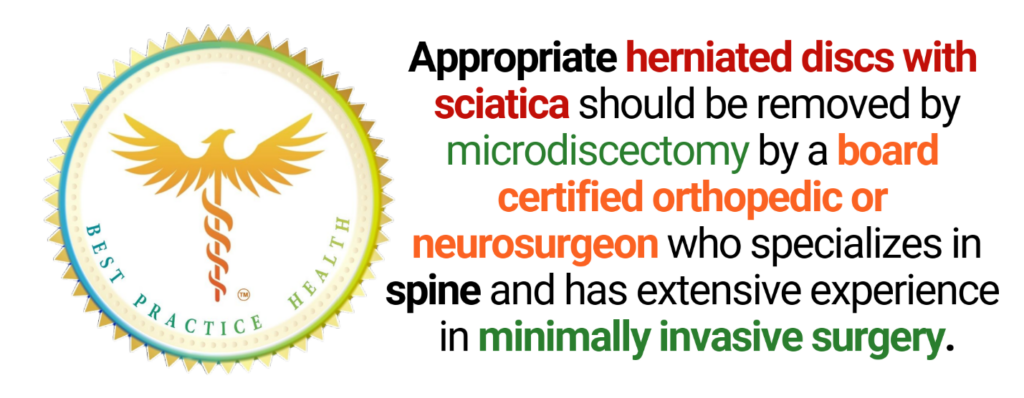The Top Microdiscectomy Surgeons for a Herniated Disc with Sciatica in Gilbert AZ and the East Valley
Herniated discs can cause severe back and leg pain (sciatica). Fortunately, like most spinal conditions, herniated discs usually get better on their own over 6-12 weeks. Spinal epidural injections are a good way to temporarily relieve sciatica caused by a herniated disc as your body heals. However, in many cases the pain from a herniated disc is unbearable even after epidural injection. That is one of the three situations in which microdiscectomy surgery is needed. After reading this page you will know 3 things:
1. When you need to act and have microdiscectomy surgery.
2. The Best Practice qualifications for picking a microdiscectomy surgeon.
3. The names of the top microdiscectomy surgeons in Gilbert and the East Valley.

When Microdiscectomy Surgery Is Needed
Microdiscectomy is the surgical removal of a herniated disc. These days the procedure is always done using magnification and light from a microscope or endoscope. Herniated discs are right next to nerve roots, so magnification and strong light make the operation safer.
Nobody wants to have invasive surgery if they don’t need it; however, there are 2 main reasons you may need a microdiscectomy. The first (mentioned above) is unbearable pain. If you’ve been to the emergency room and left without any relief, you know both unbearable pain and frustration. That is what we are talking about.
The second reason you may need a microdiscectomy is to avoid permanent nerve damage. Herniated discs damage nerve roots by compression and inflammation. The longer you suffer with numbness or weakness the more likely it is to become permanent. If you have trouble walking due to numbness or weakness, then you should see a Best Practice Certified Spine Surgeon for microdiscectomy urgently.
Although fortunately very rare, there is the potential for paralysis and incontinence due to large, herniated discs compressing multiple nerve roots. This is called cauda equina syndrome. Numbness in your private areas, weakness or pain in both legs, or trouble emptying your bladder are all signs. If you have ANY signs of cauda equina syndrome you need to act. Head immediately to Dignity Chandler Regional Medical Center. As a trauma hospital Chandler Regional is equipped and staffed to handle neurological emergencies.
Best Practice Criteria For Microdiscectomy Certification
Once you know you need microdiscectomy surgery the best surgeon is the safest one you can find who gives you the best chance of an excellent result. The principal risks of microdiscectomy surgery are recurrent or residual disc herniation, nerve root damage, infection, and spinal fluid leak. Training, experience, and micro-surgical technique reduce the risk of these complications. The safest microdiscectomy surgeon is therefore the ones who do the least invasive spine surgery with the best training and microsurgical technique.
Training. Neurosurgeons undergo at least 3 years training in microsurgery of the brain and lumbar spine during their Residency after medical school. Orthopedic spine surgery specialists complete a year of dedicated spine surgery fellowship. In addition to licensure by the Arizona Medical Board, Doctors from both of these specialties should be certified by their Specialty Medical Boards so you can be sure they have proper training and practice standards.
Microsurgical Technique. The optimal microsurgical technique depends on the location of the disc herniation. About 5% of herniated disc fragments are off to the side of the spine. If your MRI report says you have a far lateral disc herniation, then an endoscopic approach is right for you. In Gilbert the best endoscopic surgeons are with the Desert Institute for Spine Care practice near Mercy Gilbert Medical Center.
For the remaining 95% of disc herniation that are not “far lateral,” the best microsurgical approach is a microscope with a tubular retractor. Neurosurgeons such as Dr. Robert Koffie, MD and Niteen Andalkar are good examples of microsurgeons who use this technique.
The Best Practice Standards for Microdiscectomy Surgeons are:
- Board Certified in Neurosurgery or Orthopedics. Orthopedic spine specialists must also be fellowship trained in spinal surgery.
- Consistent use of a microscope or endoscope.
- Minimally invasive (typically tubular) retractor
- Ambulatory surgery center
Best Practice Certified Spine Surgeons for Microdiscectomy in Gilbert And The East Valley
To learn more about microdiscectomy surgery, check out our articles and videos!
FAQ:
What is the difference between microdiscectomy and laminectomy?
Microdiscectomy is the surgical removal of a herniated disc causing sciatica. Laminectomy is the decompression of the lumbar spine for leg pain caused by spinal stenosis. Similarly, an epidural injection may be a temporary way to control sciatica from a herniated disc, but epidural injection is not appropriate for spinal stenosis.
What is the best hospital for spine surgery in the East Valley?
Trick question. There isn’t one. Oasis Hospital specializes in orthopedic procedures. However, Oasis Hospital is not actually in the East Valley, and hospitals are no longer the best place for spine surgery. To avoid hospital errors and staph infections most people today prefer to have surgery in the safety and convenience of an ambulatory surgery center. Phoenix Spine and Joint Gilbert is the only ambulatory surgery center in the East Valley that specializes in spine surgery and has only Best Practice Certified doctors.*
*Disclaimer – PS&J Gilbert has some shared ownership with this website.







